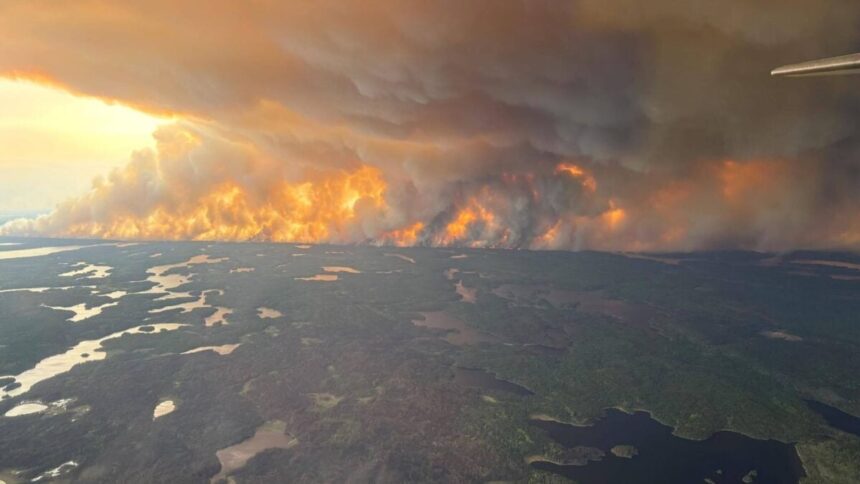The Trump administration announced its intention earlier this week to rescind the 2001 Roadless Area Conservation Policy, also known as the “Roadless Rule,” which restricts road-building, logging, and mining across 58 million acres of the country’s national forests.
The administration’s rationale was that the “outdated” Roadless Rule has exacerbated wildfire risks. In a statement announcing the policy change, U.S. Agriculture Department Secretary Brooke Rollins said that “properly managing our forests preserves them from devastating fires and allows future generations of Americans to enjoy and reap the benefits of this great land.”
Fire ecologists agree that the U.S. needs to step up land management efforts to reduce the likelihood of dangerous conflagrations. But experts don’t think more roads penetrating the country’s protected national forests is the best way to do that. Most fires — especially those that significantly affect communities—start on private lands that aren’t affected by the Roadless Rule, and remote areas can usually be managed for fire risk using flown-in firefighters.
Rescinding the Roadless Rule “does not change our current federal land management capacity to improve management and stop wildfires,” said Camille Stevens-Rumann, interim director of the Colorado Forest Restoration Institute and an associate professor of forest management and rangeland stewardship at Colorado State University. “What opening up currently roadless areas really does is allow for timber extraction.”
Before the Forest Service—an agency of the USDA—finalized the Roadless Rule at the very end of the Clinton administration in 2001, the agency struggled to pay for the maintenance of existing roads in national forests, let alone the construction of new ones.
But the policy has been controversial, facing multiple challenges from states, private companies, and GOP lawmakers who saw the rule as an impediment to commercial logging. It was repealed in 2005 by the administration of then-president George W. Bush, but reinstated the following year by a federal district court. Lawsuits from states including Alaska and Idaho have attempted to carve out exemptions for their forests, and some Republican lawmakers have facilitated land transfers from federal ownership in order to circumvent Roadless Rule protections.
Most recently, in 2020, during President Donald Trump’s first term, the Forest Service rolled back the Roadless Rule for the 9 million-acre Tongass National Forest in Alaska. Republican Senator Dan Sullivan of Alaska praised the repeal “fostering opportunities for Alaskans to make a living.” But that decision was reversed in 2023 under then-president Joe Biden.
This time around, the Trump administration is deemphasizing logging as a rationale for nixing the Roadless Rule. The USDA press release on the decision only briefly touches on the industry, saying that the Roadless Rule “hurts jobs and economic development” and that repealing it will allow for “responsible timber production.” The communication devotes more attention to the supposed wildfire risk that the rule creates, pointing out that 28 million acres of land covered by the rule are at high risk of wildfire, and arguing that repealing it will “reduce wildfire risk and help protect surrounding communities and infrastructure.”
Forest Service Chief Tom Schultz, in a column posted to the Forest Service website, said the amount of land lost to wildfire in roadless areas each year has “more than doubled” since the Roadless Rule’s inception, though he does not provide evidence that this is because of the Roadless Rule and not other factors like climate change and the hotter, drier conditions associated with it. Schultz did not respond to a request for comment.
The implication of the USDA and Forest Service’s statements is that roads can help get firefighters and equipment to remote forests to reduce their risk of fires, or fight fires when they break out. It’s true that land managers sometimes need access to densely forested areas to get rid of overgrown plants and dead wood that could fuel a small blaze and turn it into an out-of-control fire. They do this with practices known as tree thinning, which involves the removal of small shrubs and trees, and prescribed burns—intentionally set, carefully managed fires.
But five experts told Grist that the relationship between roads and forest fires is not as simple as the USDA’s announcement implies. Although roads can help transport firefighters and their gear to the wilderness—whether to fight existing wildfires or to conduct prescribed burns—they also increase the risk of unintentional fires from vehicles and campfires.
“If we’re gonna say which one leads to a greater risk”—roads or no roads—“I don’t think we have the full picture to assess that,” said Chris Dunn, an assistant professor of forest engineering, resources, and management at Oregon State University. “Those two components might counteract each other.”
In a 2022 research paper looking at cross-boundary wildfires—meaning those that move between private lands and lands managed by the Forest Service, including roadless areas—Dunn and his co-authors found that the vast majority of wildfires start on private lands, with ignitions rising as a function of an area’s road density. In other words, more roads are associated with more fires. This research also showed that most fires that destroy 50 buildings or more are started by humans on private lands.
Another study, this one from 2021, focused on roads and roadless areas within 11 Western states’ national forests. Dunn and his co-authors found that most wildfires between 1984 and 2018 started near roads, not in roadless areas, and that there was no connection between roadlessness and the “severity” of a fire — the amount of vegetation it killed. However, fires in roadless areas were more likely to escape initial suppression efforts, and they tended to burn a larger area.
Dunn noted that not all big, severe, remote fires are bad. Some ecosystems depend on occasional burning, and his research suggests that the greater size of fires in roadless areas can make landscapes more resilient to climate change. A problem arises when forest managers look at forests exclusively “through the lens of timber and dollar signs on trees,” he said, which can create a bias against tree mortality—even if it’s ecologically healthy for trees to burn or get thinned out by workers. That economic perspective seems to match that of the Trump administration, which has repeatedly referred to public lands and waters in terms of their “resource potential.”
Steve Pyne, a fire expert and emeritus professor at Arizona State University’s Center for Biology and Society, agreed with other experts. Grist spoke with that rescinding the Roadless Rule “is not about fire protection; it’s about logging.” In April, USDA Secretary Rollins directed regional Forest Service offices to increase timber extraction by 25 percent, in line with an executive order Trump signed in March ordering federal agencies to “immediately increase domestic timber production.”
In response to Grist’s request for comment, a USDA spokesperson said that, “while some research indicates that roads can increase the likelihood of human-caused fires, they also improve access for forest management to reduce fuels and for fire suppression efforts.” They declined to respond to a question about opening up public lands for logging interests, except to say that the agency is “using all strategies available to reduce wildfire risk,” including timber harvesting.
Even if it were certain that more roads mitigate fire risk, it’s not clear that rescinding the Roadless Rule will lead to more of them being constructed. James Johnston, an assistant research professor at the University of Oregon’s Institute for Resilient Organizations, Communities, and Environments, said the Forest Service lacks the personnel and funding to maintain the road system it already has, and building new ones is likely to be a challenge. The Trump administration has only exacerbated the problem by firing 10 percent of the agency’s workers since taking office.
“Nobody is going to next week, next month, or any time in the future build roads across an area the size of the state of Idaho,” he said, referring to the 58 million acres covered by the Roadless Rule. Private companies that want to build new roads on public lands also face barriers to road construction because they need to obtain environmental permits, he added. New roads on Forest Service land would have to comply with statutes like the Endangered Species Act and the Clean Water Act. Johnston also noted that many roadless areas are unsuitable to roads because they are too steep or rocky.
Ryan Talbott, Pacific Northwest conservation advocate for the nonprofit WildEarth Guardians, noted that it will take time for the USDA to legally rescind the Roadless Rule. “There’s a process,” he said. “In ordinary times they would put a notice in the Federal Register announcing that they intend to rescind the Roadless Rule, and then there would be a public comment process and then eventually they would get to a final decision.” The USDA spokesperson told Grist that a formal notice would be published in the Federal Register, the government’s daily journal that publishes newly enacted and proposed federal rules, “in the coming weeks.”
Stevens-Rumann, at Colorado State University, said that if the Trump administration were serious about mitigating wildfire risk, it would make more sense to increase Forest Service funding and personnel and, critically, to conduct tree-thinning and prescribed burns in areas that already have roads. “We have a ton of work that we could be doing in roaded areas before we even go to roadless areas,” she said.
This article originally appeared in Grist at https://grist.org/wildfires/wildfire-prevention-roads-trump-repeal-roadless-rule-usda-forest-service/. Grist is a nonprofit, independent media organization dedicated to telling stories of climate solutions and a just future. Learn more at Grist.org.
Read the full article here












